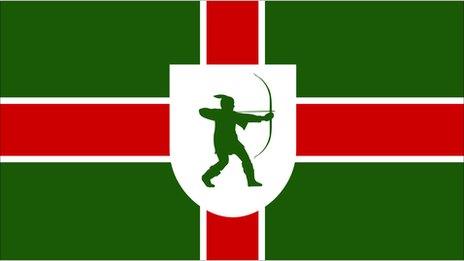Flying the county flag: The preservation of an identity
- Published
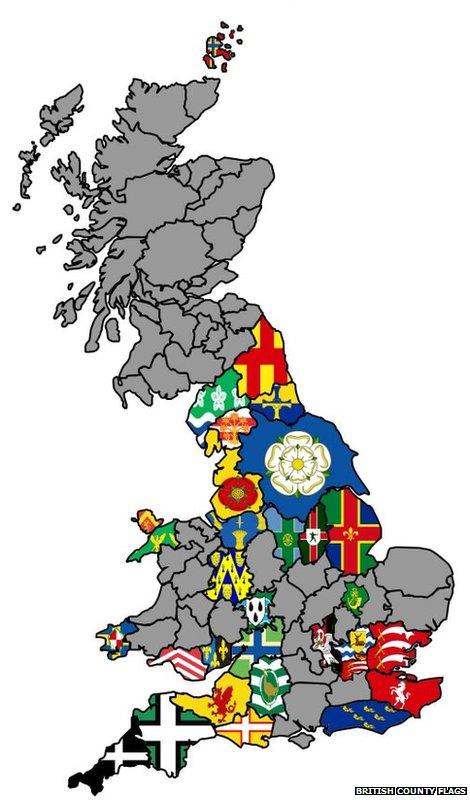
Symbols, patterns and colours have been used for millennia as ways to rally the troops, frighten foes, inspire loyalty, and recognise allies.
Think Native Americans using war paint to intimidate their enemies, the clan tartan of the Scots, standard bearers on the battlefield.
Does anything fulfil that unifying role today - and does anyone care?
Country flags fluttering in the breeze are a common sight, but flying the county flag has been relatively rare.
They are, though, experiencing something of a boom.
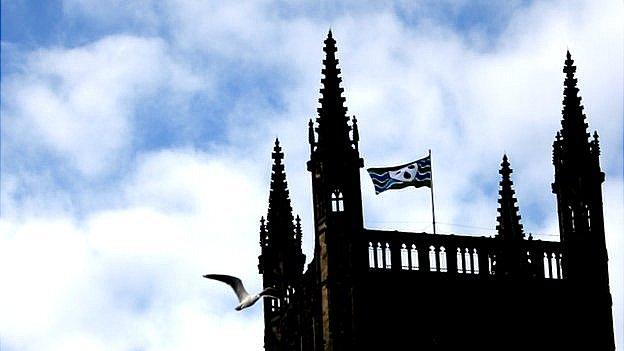
Six new county flags were registered last year, the highest ever yearly number, and more than half of England's 30 historical county flags have been registered since 2000.
A further 15 are in the pipeline, according to the Flag Institute, which maintains and manages the national United Kingdom Flag Registry.
So what is driving the movement?
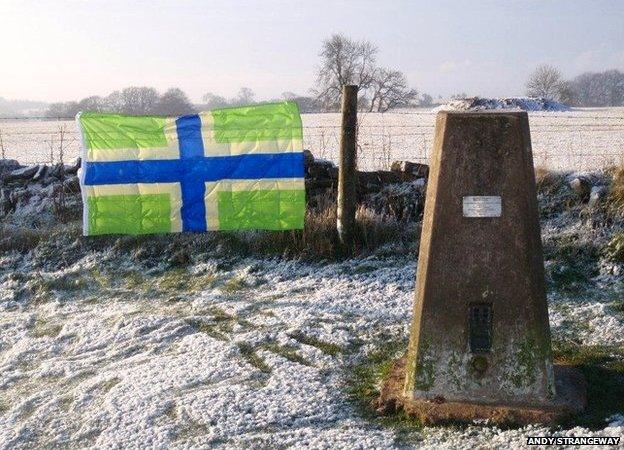
Gloucestershire's Severn Cross flag was the winner of a competition organized by the county's High Sheriff
To understand the point of county flags, the role of the counties themselves must be considered, said Dr Kenn Casey, a retired lecturer in social history.
"They give their names to clubs, societies, military regiments, and sports teams," he said.
"But most importantly, they are places where people think they "belong".
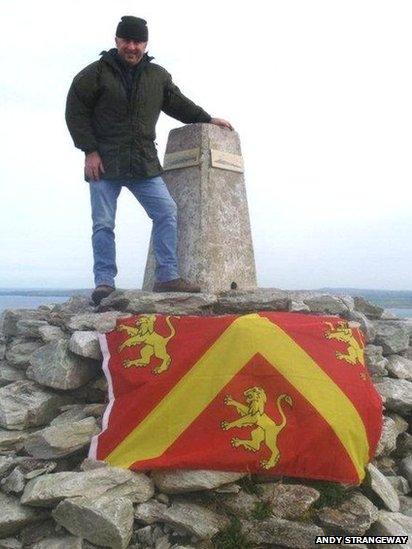
Andy Strangeway, a campaigner for the recognition of historic counties, raised awareness by sleeping at the highest point in every county in Great Britain. If the county had an official flag, he took it with him.
The Local Government Act of 1974, which introduced administrative counties based on the local authority, seemed to eliminate some counties overnight by moving the geographical boundaries.
But this is not the case.
An activist for the recognition of traditional counties, external, Andy Strangeway, whose campaigns have established a handful of new flags, explained: "On 1 April 1974 I was a young lad who had gone to bed the previous night in the East Riding and woke up in Humberside - or so the powers that be like us to believe.
"The truth is that the River Tees is still the boundary between Yorkshire and County Durham and the River Humber is still the boundary between Yorkshire and Lincolnshire today as it has been for over 1,100 years."
On Saint George's Day last year, Eric Pickles, Secretary of State for Communities and Local Government asserted that England's historic and traditional counties still exist, external, and are now recognised by the government - including the likes of Cumberland, Huntingdonshire, Westmorland and Middlesex.
The county flag plays a crucial role in promoting recognition of traditional boundaries and names, according to Jason Saber, from the Association of British Counties.
"The county flag is a highly effective weapon in our arsenal," he said.
"A bright eye-catching design rippling in the breeze will attract attention of itself and invariably lead to an enquiry about what or where it represents."

Regional flags for Yorkshire's East Riding, North Riding and West Riding. All were chosen by public vote last year, after a campaign led by Andy Strangeway

Flags for County Durham, Lincolnshire and Yorkshire

Some of the proposed designs for (l-r) Bedfordshire, Surrey, Hampshire and Suffolk
Mr Pickles said the widespread flag flying during the royal wedding, Diamond Jubilee and Olympics is evidence of a gradual cultural change in Britain.
"Flags deserve our respect.
"Not only do they convey power and status but they can create deep pride and bring unbridled joy," he added.
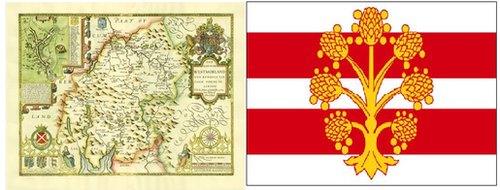
The historic county of Westmorland, and the county's official flag which was registered in 2011
Social psychologist Rachelle Dwyer said there is some truth in Mr Pickles' suggestion that public celebrations could have triggered an interest in community feeling.
"Street parties and the like got people together.
"In a fast-moving society where it is common for people not to know their neighbours, there would be a certain comfort in rediscovering community spirit, and a reluctance to abandon it," she said.
Can that alone explain the recent surge of interest in county flags?
Logically, no.

The flag of Essex is ancient in origin and features three Saxon seaxes
The earliest of Mr Pickles' examples, the royal wedding, took place in 2011. But the increase began a decade before that.
In 2002, the county flag for the Isles of Scilly was registered after a campaign by a local newspaper, the Scilly News.
It opened the floodgates. In the next 12 years, more than a third of new flags were established as a result of competitions held by local media.
They generate publicity for the press, which has a vested interest in encouraging people to identify themselves with their counties.
A third reason, according to Mrs Dwyer, is simply human nature.
"When someone sees a county with a flag, their reaction could be "I want one too.""
Envy aside, is there a point in having a flag, and do they mean anything to the communities they represent?
It depends, said Dr Casey.
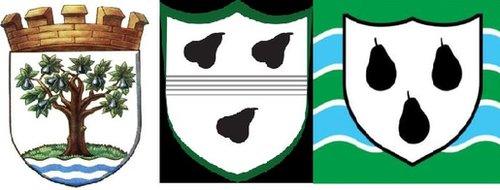
Worcestershire's county council, cricket team and county flag all bear pear tree symbols
Arms belonging to a county council may be incorporated into any flag, but they belong solely to the organisation to which they were granted, and do not, as is often assumed, represent the county as a whole.
But that very assumption means counties already have symbolic identities - Essex's swords, Lancashire's red rose, Yorkshire's white.
Worcestershire's official flag, granted a year ago, features the black pear - the emblem borne by men from the county at the Battle of Agincourt - and a green and blue background symbolising the floodplain of the River Severn as it runs through the county.
The pears are already on the county council's arms, Worcestershire County Cricket Club's banner, and pub signs.
The Worcestershire Rifle Volunteers of 1859 used the Pear Tree as their emblem until 1908, while pear blossom was shown as a badge by the Worcestershire Yeomanry Cavalry from the beginning of the 20th Century until 1956.
In cases like these, where administrative counties tally with the historical ones, Dr Casey argues a new flag adds little: "There is no motivation to feel particularly passionate about it."
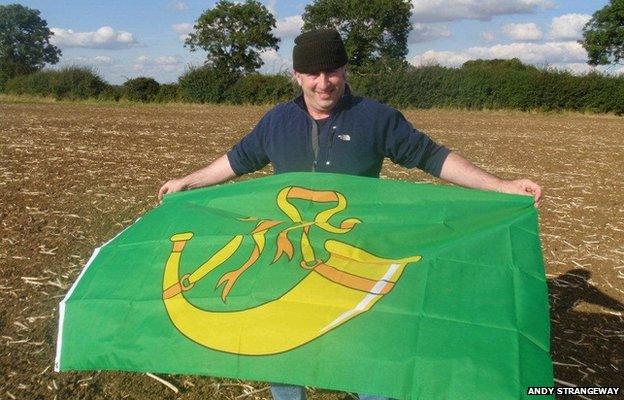
The Huntingdonshire flag, which was established by the Huntingdonshire Society
But when the historical county is no longer an administrative one, a flag assumes a much greater importance.
"People still identify with those counties - there are still Middlesex, Huntingdonshire and Cumberland county cricket clubs, and a Westmorland cricket league," he said.
A county flag can reinforce that sense of identity where it might otherwise become fragile.
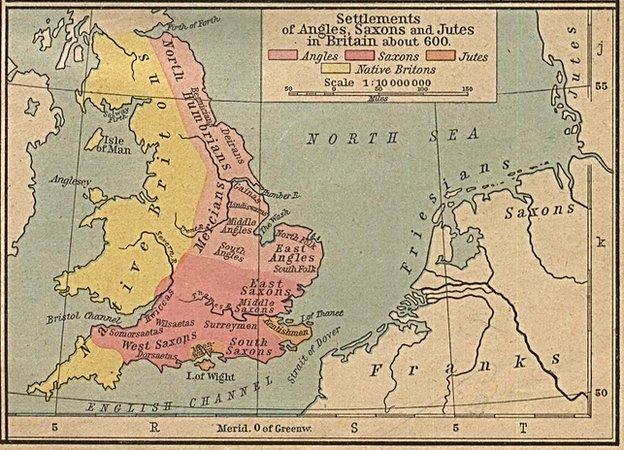
The seven kingdoms of Anglo Saxon England: Mercia, East Anglia, Northumbria, Wessex, Essex, Kent and Sussex
People living in Cumberland or Westmorland, for example, now officially live in Cumbria under the remit of Cumbria County Council.
"If someone is told something enough, they will eventually come to believe it," said Mrs Dwyer.
"So there is a chance a strong identity would be compromised."
In response to the disappearance of their administrative county, a Huntingdonshire Society was set up to promote awareness of the historic county.
In 2009, the organisation was successful in registering an official Huntingdonshire flag.
One obvious exception is Cornwall, where the historical county and administrative one are the same, but the flag is well known and well represented.
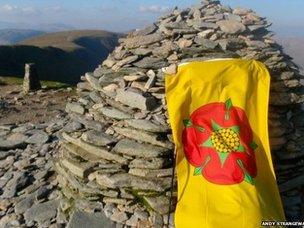
The red rose is the traditional symbol of Lancashire and yellow and red are the livery colours of the county
Cornwall is historically a Celtic land, and is not one of the seven kingdoms of Anglo Saxon England: Mercia; East Anglia; Northumbria; Wessex; Essex; Kent and Sussex.
The peninsula has its own language and four elected county councillors, external from a nationalist party.
According to Cornwall Council, in the 2011 census 73,200 people out of a total population of 530,000 said they had a distinct Cornish, rather than English, national identity.
From this perspective, the Cornish flag is not a county flag at all, but comparable to the Scottish saltire, the Welsh dragon or England's cross of Saint George.
So do any symbols, patterns or colours fulfil that unifying role to rally the troops, frighten foes, inspire loyalty, and recognise allies?
And does anyone care?
The answer to both questions, in Dr Casey's words, is "sometimes".
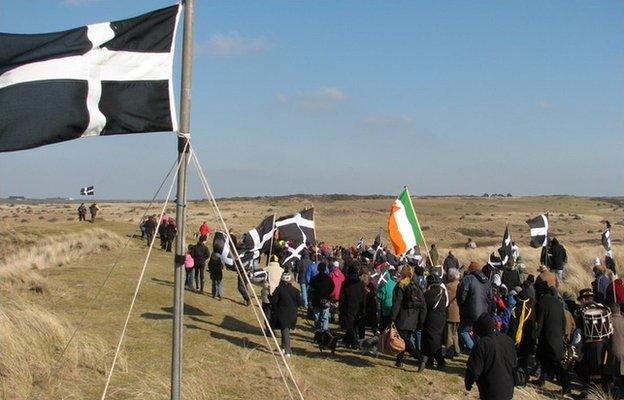
St Piran's day is celebrated in Perranporth, Cornwall, with an annual procession
- Published8 April 2013
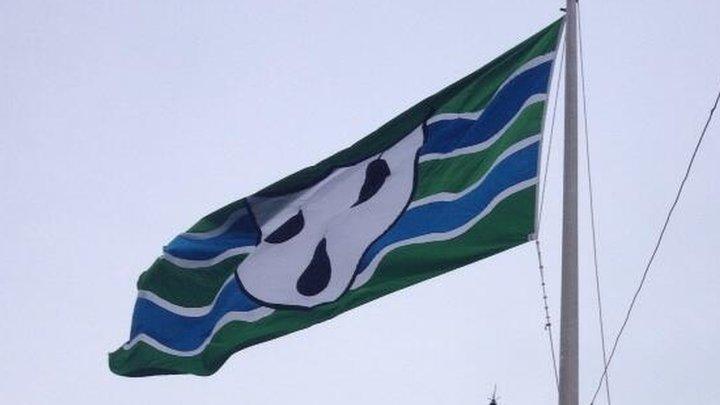
- Published7 January 2013
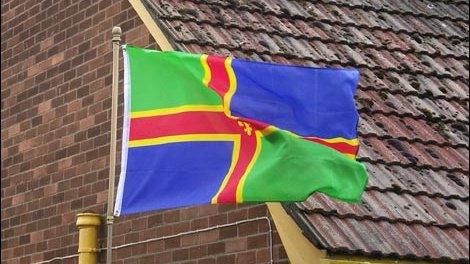
- Published20 May 2011
